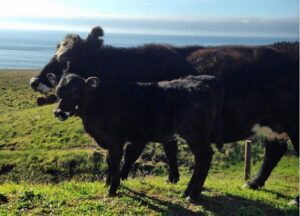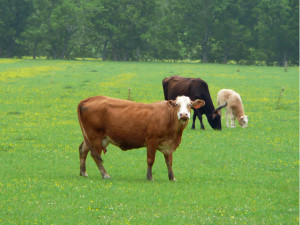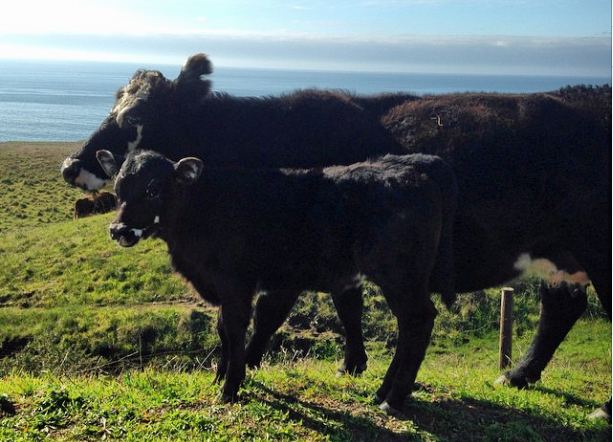by Amy Myrdal Miller, MS, RDN
Founder and President, Farmer’s Daughter Consulting, LLC
I was in Costco the other day when I overheard a woman telling her husband, “We need to buy the grassy beef, dear. It’s better for the planet.” Her husband then complained about the price, got fed up with arguing with her, and walked away. I empathized with him. His wife is wrong about “grassy” beef being “better for the planet.” But I also empathize with any shopper trying to make the “right” choice when it comes to beef. The U.S. beef industry is rather complicated. Here are some facts that may help you make more informed decisions.
FACT: All cattle start their lives drinking milk and eating grass.
All cattle start their lives in cow-calf operations on land typically not suited for growing crops. The farm I grew up on in North Dakota had a cow-calf operation for many years. The cows and calves grazed on grass land that was ridden with rocks and couldn’t be farmed. The cow-calf operation turned unproductive land into a revenue-generator for the farm.

Photo by Amy Myrdal Miller, taken on the Pacific Coast Highway in Sonoma County, California (January 3, 2015)
FACT: Grass-finished cattle live longer, and therefore have a larger environmental impact.
Calves stay with their mothers drinking milk and eating grass until they can be weaned, typically when they reach 450-700 pounds, depending on the breed. The vast majority of calves in the U.S. are then sent to feedlot operations at 6-12 months of age. The feedlots feed them until they reach slaughter weight, or approximately 1200 pounds, which takes about 3-6 months. Grass-finished cattle remain in pastures, foraging for grass until they reach slaughter weight, which takes more time. The longer cattle live, the greater their impact on the planet. They use more water, feed, and land, and they produce more methane.

Photo by Amy Myrdal Miller, taken in Yolo County, California (September 10, 2008)
FACT: All cattle produce methane, a greenhouse gas.
Cattle are ruminants, which means they have four compartments in their stomachs, one of which is called the rumen. Bacteria in the rumen, called methanogens, help break down feed into energy for the cattle. This process is called enteric fermentation, which produces methane that the cattle belch out into the atmosphere. Enteric fermentation is what allows grass, hay, almond hulls, and other non-digestible matter that humans can’t eat to be turned into energy for cattle.
There are many sources of man-made methane, including industry, agriculture, and waste from homes and businesses, including food waste. Man-made methane accounts for about 60 percent; natural sources account for the rest. According to the Environmental Protection Agency, methane is second only to carbon dioxide in terms of sources of man-made greenhouse gas emissions in the U.S.
FACT: There are four types of beef available in the U.S.
If you’re trying to choose between grass-fed and grain-fed beef, you should know there are actually four types of beef sold in the U.S.—grain-fed, grass-finished, certified organic, and natural beef. These categories are based on production methods, and are not related to quality grades (think prime, choice, select) that are based on how tender, juicy, and flavorful the meat is.
FACT: Grain-fed cattle eat more than grain.
Grain-fed refers to cattle that are “finished” in feedlots, eating corn, soybeans, sorghum and other grains along with “roughage” that can include hay, almond hulls, cotton by-products, or other by-products of the food and fiber industries. The goal of a feedlot operation is to get healthy cattle to reach market slaughter weight as quickly as possible. The cattle have room to move, 24-7 access to fresh water, and daily rations of feed that promote good health and rapid growth.
FACT: The term “natural” has multiple meanings when it comes to beef.
By U.S. government definition, most beef sold in the U.S. is natural. According to the USDA Food Safety and Inspection Service (FSIS), “natural” may be used on a label for meat if it does not contain any artificial flavor or flavoring, coloring ingredient, chemical preservative or any other artificial or synthetic ingredient, and the product and its ingredients are not more than minimally processed.
The USDA Agricultural Marketing Service (AMS) will provide a “naturally raised” certification is the beef comes from cattle that have never received growth hormones, have never been administered antibiotics, and were not fed animal by-products. The term “naturally raised” does not mean the cattle were grass fed.
FACT: Certified organic beef can come from cattle finished on either grain or grass.
Beef that qualifies for the certified organic label can come from cattle that were either grain-finished or grass-finished, as long as all other National Organic Program livestock production requirements are met, as follows:
- Cattle must be fed certified organic feed but may be given certain vitamin and minerals.
- Organically raised cattle may not be given growth promotants or receive antibiotics.
- Organically raised cattle must have access to pasture.
FACT: Grass-fed and grain-fed beef nutrition doesn’t differ significantly.
According to USDA Nutrient Database data, grain-fed beef—on average—contains more total fat and calories than grass-fed beef. While there may be significant differences depending on the feed (e.g., some herds of grass-fed cattle are given supplemental flax seed, which will increase the amount of omega-3s in the beef), on average the calorie and nutrient differences are insignificant.
| Nutrient |
Beef, grass-finished, ground, raw |
Beef, grain-fed, ground, raw |
| NDS Database Number |
13047 |
23567 |
| Weight, g |
85 |
85 |
| Calories |
163 |
183 |
| Total Fat, g |
10.82 |
12.75 |
| Saturated Fat, g |
** |
** |
| Polyunsaturated Fat, g |
** |
** |
| Omega-3 FA, g |
** |
** |
| Monounsaturated Fat, g |
** |
** |
| Protein, g |
16.51 |
15.80 |
| Iron, mg |
1.69 |
1.78 |
| Sodium, mg |
58 |
56 |
| Potassium, mg |
246 |
251 |
| Zinc, mg |
3.87 |
3.81 |
FACT: There’s a lot of variability in beef nutrition, based on breed, feed, and other factors.
This is a quick summary of the factors that affect the nutrient qualities of beef.
- Cattle Breed: Some cattle produce leaner or fattier tissue.
- Seasonal Variations in Grass Type or Quality: Some grasses, like alfalfa, are more nutrient-rich than others and will produce variations in the nutrient content of the beef.
- Use of Supplemental Feed or Grain: If grass-fed cattle are not getting enough nutrition from grazing in a pasture, the rancher will supplement their diets with corn, soybeans or sorghum.
- Type of Grain: The type of grain will also affect the quality of the beef.
- Activity Levels: Cattle that are fed in a feedlot may move less than cattle that are pasture-fed, which may be leaner due to the physical activity as well as the caloric density of the grass compared to grain.
The Bottomline
If you’re choosing grass-finished beef because you think it’s better for the planet, think again. The cattle live longer and therefore have a greater environmental impact.
If you choose grass-finished beef because you like the flavor better, that’s another issue. I grew up eating grass-finished beef, and I love the “beefier” flavor of a “grassy” T-bone steak compared to a grain-finished steak. But I’d never buy grass-finished ground beef. The flavor differences are masked by other ingredients, whether in a spaghetti sauce or cheese burger with all of my favorite toppings, especially umami-rich mushrooms!
Speaking of mushrooms, my next blog will focus on sensory research I published recently about the sensory, sustainability, and cost impacts of using mushrooms blended with ground beef in mixed dishes .

